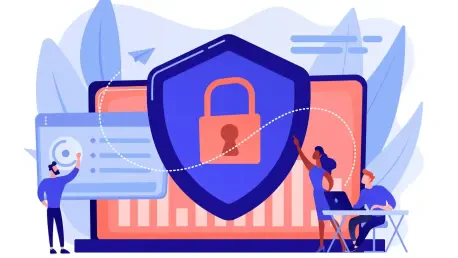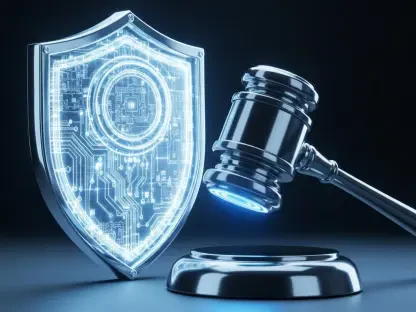EU data protection regulations, notably the General Data Protection Regulation (GDPR), the NIS2 Directive, and the Digital Operational Resilience Act (DORA), are spurring the development of advanced email security measures. Businesses must secure their digital communication channels, with a strong focus on email, to comply with these regulations and safeguard sensitive information.
GDPR’s Impact on Email Security
Stricter Data Protection Standards
The implementation of GDPR in 2018 dramatically altered data protection norms, mandating rigorous security practices. This regulation emphasizes encryption as a critical component and imposes severe penalties for data breaches, compelling organizations to secure email exchanges. Given that emails often carry sensitive personal data, the need for robust encryption and data protection measures has grown substantially. Organizations must implement state-of-the-art security technologies, including end-to-end encryption and multi-factor authentication, to ensure emails remain confidential and protected during transmission and storage.
Moreover, GDPR’s impact is seen in its ability to drive advancements and investments in cybersecurity infrastructure. Enterprises now prioritize email security as part of their overall data protection strategies, adopting innovative solutions that enhance privacy and mitigate risks. Encryption protocols such as S/MIME and PGP have become standard, ensuring that emails are guarded against unauthorized access. As GDPR continues to influence data protection practices globally, organizations increasingly view secure email communications as indispensable for legal compliance and safeguarding consumer trust.
Consequences of Non-Compliance
Unsecured emails pose a significant risk of data breaches, leading to potentially hefty fines under GDPR. Organizations are thus encouraged to implement state-of-the-art security measures, including end-to-end encryption, to protect personal data and ensure compliance. GDPR’s stringent requirements mean that any lapse in email security can result in severe financial and reputational damage. Beyond fines, non-compliance can lead to broader legal repercussions, including lawsuits and audits, further compounding the challenges organizations face.
In addition, non-compliance can erode customer trust and damage business relationships. Clients and partners expect that their data will be handled with the utmost care, and any breach of this trust can have lasting impacts. To avoid these pitfalls, organizations must stay updated on GDPR guidelines and continually enhance their email security protocols. Regular audits, employee training, and investment in advanced encryption technologies are crucial steps in maintaining compliance and protecting sensitive data.
Expansion Under the NIS2 Directive
Broadening Industry Coverage
The NIS2 Directive expands its predecessor’s reach, including more sectors such as digital services, manufacturing, and energy. It enforces stronger encryption standards and breach reporting obligations, demanding companies in critical industries uphold robust cybersecurity controls. This broader scope underscores the growing recognition that various sectors are vulnerable to cyber threats, necessitating comprehensive protection measures for email communications. Organizations must now demonstrate their ability to secure their digital infrastructure against sophisticated attacks, a requirement that places significant emphasis on email encryption and security protocols.
With NIS2, industries previously less regulated in terms of cybersecurity are now subject to rigorous standards. This shift means that more businesses must invest in specialized security solutions to protect email data against breaches and unauthorized access. By extending its coverage, NIS2 aims to create a uniform security baseline across different sectors, ensuring that all critical industries are equipped to defend against ever-evolving cyber threats.
Enhanced Security Requirements
NIS2’s stricter rules mean that email communications, often targeted by cyberattacks, must be securely encrypted. This directive ensures that organizations maintain high standards of email security to prevent breaches and protect sensitive data. Strong encryption not only guards against external threats but also secures internal communications, preventing confidential information from being leaked or misused. Companies are thus required to implement advanced encryption technologies and continuously monitor their email systems for potential vulnerabilities.
Additionally, enhanced security requirements under NIS2 mandate regular security assessments and incident reporting. Organizations must be proactive in detecting and responding to potential threats, ensuring that any breaches are swiftly addressed and mitigated. This proactive approach helps to minimize the impact of cyberattacks and reinforces the importance of robust email security as a critical component of overall cybersecurity strategies. As a result, businesses are investing in technologies that offer real-time threat detection, automated encryption policies, and comprehensive monitoring capabilities to comply with NIS2 and safeguard their operations.
DORA and Financial Sector Resilience
Focus on Financial Institutions
The Digital Operational Resilience Act (DORA) targets the financial sector, requiring financial institutions to maintain secure communication channels. Email protection becomes vital as institutions handle high-value transactions and sensitive customer data. Financial entities must adopt stringent cybersecurity measures to protect against the increasing sophistication of cyber threats. This includes implementing comprehensive encryption protocols, ensuring that emails are secured during transmission and at rest, and preventing unauthorized access to sensitive financial information.
DORA emphasizes the importance of a holistic approach to operational resilience, integrating email security into broader risk management frameworks. Financial institutions are required to not only invest in advanced encryption technologies but also develop robust incident response plans and conduct regular security audits. These measures ensure that financial organizations can quickly detect and respond to potential threats, minimizing the risk of data breaches and maintaining the integrity of their communication channels.
Continuous Threat Monitoring
Under DORA, financial entities must employ strong encryption and continuous monitoring to detect threats. Email protection is integral to operational resilience, ensuring secure handling of confidential information and compliance with regulatory standards. Continuous monitoring allows financial institutions to identify and address potential security vulnerabilities in real-time, enhancing their ability to prevent and mitigate cyberattacks. This proactive approach helps to ensure that emails carrying sensitive financial data are consistently protected against emerging threats.
Furthermore, DORA’s focus on continuous threat monitoring requires financial institutions to invest in advanced cybersecurity technologies that can detect and respond to anomalies. Artificial intelligence and machine learning play a critical role in enhancing email security, enabling automated threat detection and response capabilities. By leveraging these technologies, financial entities can stay ahead of cybercriminals and ensure that their email communications remain secure and compliant with regulatory requirements. This ongoing commitment to cybersecurity not only strengthens operational resilience but also fosters trust among customers and stakeholders.
The Necessity of Robust Email Security
Risks of Unprotected Emails
Secure email practices are now indispensable for business integrity. Organizations must adopt comprehensive encryption methods to prevent credential theft, man-in-the-middle attacks, and network compromises, preserving customer trust and business relationships. The risks associated with unprotected emails are significant, as they can lead to unauthorized access to sensitive data, financial losses, and reputational damage. Consequently, businesses must prioritize email security as a fundamental aspect of their overall cybersecurity strategy.
Implementing robust email security measures involves deploying encryption technologies, ensuring secure authentication protocols, and continuously monitoring email systems for potential threats. By doing so, organizations can mitigate the risks posed by cyberattacks and secure their digital communication channels against unauthorized access. This proactive approach not only protects sensitive information but also demonstrates a commitment to data privacy and security, fostering trust among customers and partners.
Simplifying International Compliance
For companies managing international transactions, aligning with EU email security regulations simplifies operations across borders and mitigates legal risks. Compliance aids in seamless business continuity and prevents service disruptions due to data protection failures. By adhering to GDPR, NIS2, and DORA requirements, organizations can ensure that their email communications are secure and compliant with global standards. This alignment helps to reduce the complexity of managing regulatory compliance in multiple jurisdictions, allowing businesses to focus on their core operations.
Moreover, complying with EU email security regulations enhances an organization’s reputation and credibility. Clients and partners are more likely to trust and engage with companies that demonstrate a strong commitment to data protection and cybersecurity. This trust translates into better business relationships and long-term partnerships, ultimately contributing to the organization’s success. By investing in robust email security measures and ensuring compliance with international regulations, businesses can safeguard their digital assets and thrive in an increasingly interconnected world.
Innovations in Email Encryption
Advanced Encryption Solutions
Modern regulations endorse state-of-the-art encryption such as end-to-end encryption and certificate-based methods like S/MIME or PGP. Solutions from companies like Echoworx facilitate compliance with GDPR, NIS2, and DORA through customizable encryption tools. These advanced encryption solutions offer a high level of security, ensuring that sensitive data transmitted via email remains confidential and protected from unauthorized access. Organizations can tailor these tools to meet their specific security requirements, providing a flexible and scalable approach to email encryption.
The adoption of advanced encryption solutions is driven by the need to comply with stringent regulatory standards and protect sensitive information from cyber threats. As cyberattacks become more sophisticated, businesses must stay ahead of potential risks by implementing cutting-edge encryption technologies. This includes leveraging certificate-based methods that ensure the authenticity and integrity of email communications. By adopting these solutions, organizations can enhance their email security posture, reduce the risk of data breaches, and maintain compliance with international regulations.
Cloud-Based Encryption
Cloud-native encryption solutions offer scalability and flexibility, ensuring robust security for email communications across platforms like Google, Microsoft, and AWS. These solutions align with multiple regulatory requirements while maintaining operational efficiency. The integration of cloud-based encryption technologies into existing email systems provides seamless protection for sensitive data, enabling organizations to leverage the benefits of cloud computing without compromising security. This approach ensures that emails are securely encrypted both during transmission and when stored in the cloud.
The flexibility of cloud-based encryption solutions allows organizations to scale their security measures in response to changing needs and threat landscapes. By leveraging cloud-native technologies, businesses can ensure their email communications remain secure and compliant with regulatory standards, regardless of the platform used. This scalability is particularly beneficial for organizations with dynamic and growing operations, as it provides the ability to adapt to emerging security challenges while maintaining a high level of protection for sensitive information.
Challenges and AI-Driven Solutions
Balancing Security and Usability
Although strong encryption is essential, complex setups and key management pose challenges. Innovative solutions focus on simplifying encryption use while maintaining robust security, ensuring higher adoption rates and efficient key management. Organizations often struggle with the intricate processes involved in implementing and managing encryption technologies, which can hinder their overall cybersecurity efforts. To address this, companies are developing tools that streamline encryption deployment and management, making it easier for businesses to secure their email communications.
The balance between security and usability is crucial for ensuring that encryption solutions are widely adopted and effectively utilized. User-friendly interfaces and automated key management systems help to reduce the complexity of encryption processes, enabling employees to securely send and receive emails without extensive training or technical expertise. By focusing on usability, organizations can overcome the barriers to encryption adoption and enhance their overall email security posture.
Combatting Advanced Threats
To thwart sophisticated attacks like Business Email Compromise (BEC) and phishing, organizations are turning to AI-driven threat detection and automated encryption protocols. These technologies enable real-time threat detection and secure email communications, enhancing overall cyber resilience. Advanced threats such as BEC and phishing exploit human vulnerabilities and traditional security measures, necessitating the use of AI and machine learning to identify and mitigate these risks. AI-driven solutions can analyze email patterns, detect anomalies, and respond to potential threats in real-time, providing a proactive defense against cyberattacks.
Moreover, automated encryption protocols ensure that sensitive data is consistently protected without relying on manual processes. This automation helps to reduce the risk of human error and ensures that encryption policies are uniformly applied across the organization. By integrating AI and automation into email security strategies, businesses can enhance their ability to defend against advanced threats and maintain a high level of protection for their email communications. This approach not only strengthens cybersecurity but also ensures compliance with regulatory standards, safeguarding the organization’s digital assets.
Ensuring Secure Business Communication
European Union data protection regulations, particularly the General Data Protection Regulation (GDPR), the NIS2 Directive, and the Digital Operational Resilience Act (DORA), are driving the innovation of advanced email security measures. These regulations mandate that businesses enhance the security of their digital communication channels, with email being a critical focus area. The aim is to ensure compliance with these stringent regulations and to protect sensitive information from breaches or unauthorized access. As a result, companies are increasingly investing in sophisticated email security solutions to safeguard their data and maintain customer trust. Compliance with GDPR, NIS2, and DORA requires rigorous security protocols, necessitating organizations to adopt robust measures for email encryption, phishing prevention, and intrusion detection. Failure to do so can result in severe penalties and loss of reputation. Thus, firms are prioritizing email security to not only meet regulatory requirements but also to uphold the integrity of their communication and protect confidential information.









